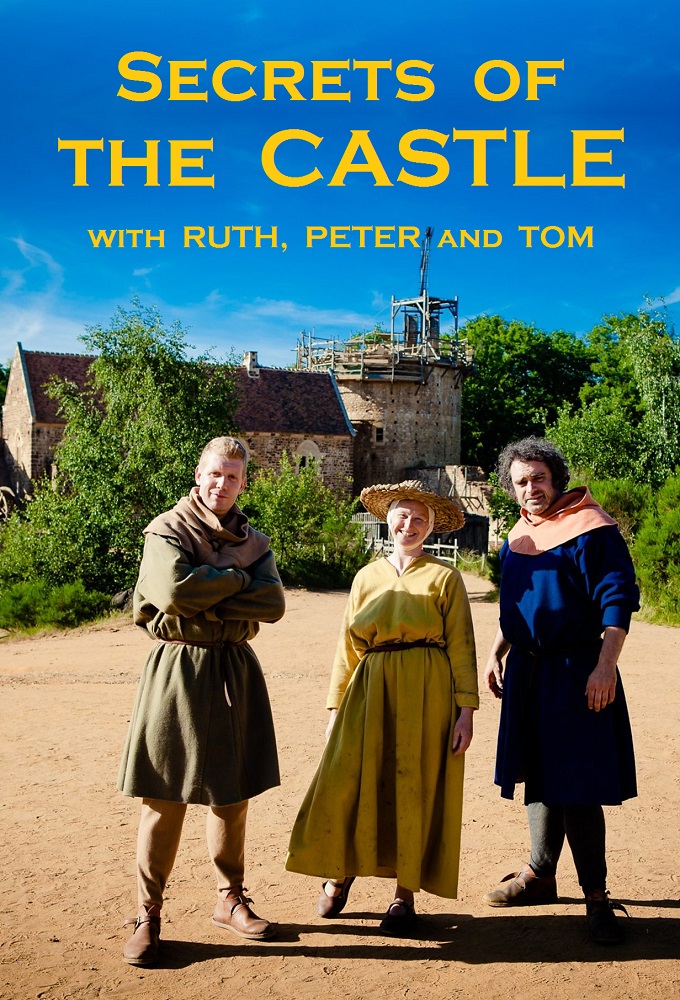
Secrets of the Castle with Ruth, Peter and Tom
Non notée
Année : 2014
Nombre de saisons : 1
Durée moyenne d'un épisode : 50 minutes
Genre(s) : Documentaire
L'historienne Ruth Goodman et les archéologues Peter Ginn et Tom Pinfold remontent le temps et lèvent le voile sur le secret des bâtisseurs de châteaux forts.
Saisons

Saison 1
Épisodes
Choisissez votre saison au dessus et découvrez les épisodes qui vous attendent !
Épisode 1 - Episode 1
18 novembre 2014
Peter and Tom set to work straight away learning the skills of the medieval stonemasons to construct a beautiful spiral staircase. After digging stone out of the quarry they take it to the tracing floor, where every stone is marked out using the most closely guarded knowledge of the medieval castle builders: geometry. Then each step is hand carved, a three-day task, before being winched into place using the treadmill-powered crane.
Épisode 2 - Episode 2
25 novembre 2014
Historian Ruth Goodman and archaeologists Peter Ginn and Tom Pinfold turn the clock back as they learn how to build a medieval castle using the same tools, techniques and materials available in the 13th century. This time the team are defending the castle. Ruth, Tom and Peter explore the art of medieval combat and the building of the castle's defensive structures. The 13th century was part of the 'golden age of castle building'. Driven by the legacy of bloody crusades and vicious dynastic struggles, it was an era when castle design and architecture were adapting as quickly as the battle strategies and tactics devised to bring them down. The team look at the ingenious features medieval castle builders came up with to withstand attack from an ever more formidable array of 'siege engines'.
Épisode 3 - Episode 3
2 décembre 2014
Historian Ruth Goodman and archaeologists Peter Ginn and Tom Pinfold turn the clock back as they learn how to build a medieval castle using the same tools, techniques and materials available in the 13th century. Ruth, Peter and Tom enter the surprisingly colourful world of medieval interior design. Peter and Tom render and limewash the inside walls of a guard tower, transforming its dark stone walls into a bright space. Ruth makes medieval paints, which were used to decorate walls with ornate patterns. Most of the pigments are from ochre extracted from the earth, burning it creates darker tones. She decorates the castle bedchamber, using designs based on those recently discovered at an 11th-century church nearby. Peter gets to grips with the castle's indoor toilets. An integral feature of medieval castles, the toilets were known as garde-robes, a French word for wardrobe. Clothes would often be kept inside them because it was believed the smell of ammonia from urine kept parasites at bay. Tom makes tiles - a process that begins with mining clay, before processing and shaping it. The tiles are then fired in a kiln. Four thousand tiles are fired at a time, requiring temperatures of over 1,000 degrees. It's a three-day process - and a tense one. If things don't go to plan months of work will be wasted... It's estimated that over 80,000 tiles will be needed for the roofs and floors of Guedelon Castle.
Épisode 4 - Episode 4
9 décembre 2014
The team delves deeper into the secrets of the skilled communities who built medieval castles. The stonemasons working on the castle walls are dependent upon blacksmiths, whose metalwork was magical to the medieval mindset, and upon carpenters employing sophisticated geometry. Ruth Goodman, Peter Ginn and Tom Pinfold discover the ways in which every aspect of construction at Guédelon Castle requires the masons, blacksmiths and carpenters to coordinate their efforts - from making and sharpening tools, to processing wood and securing timber scaffolding on the castle walls.
Épisode 5 - Episode 5
17 décembre 2014
As their time at Guedelon Castle in France draws to an end the team look at the castle's place in the wider medieval world. 13th-century Europe was a busy, developing, connected place, where work, trade, pilgrimages and crusades gave people the opportunity to travel across the continent and beyond.
Vidéos
Oups aucune vidéo pour le moment... Revenez plus tard pour des aventures en images !

Aucun avis pour le momment...